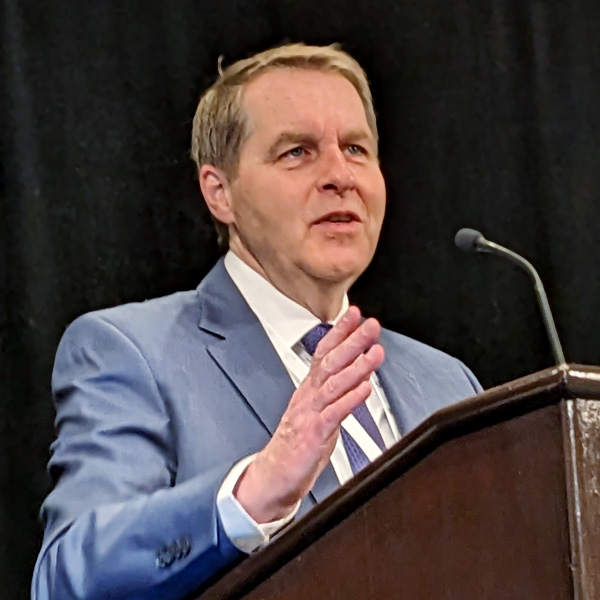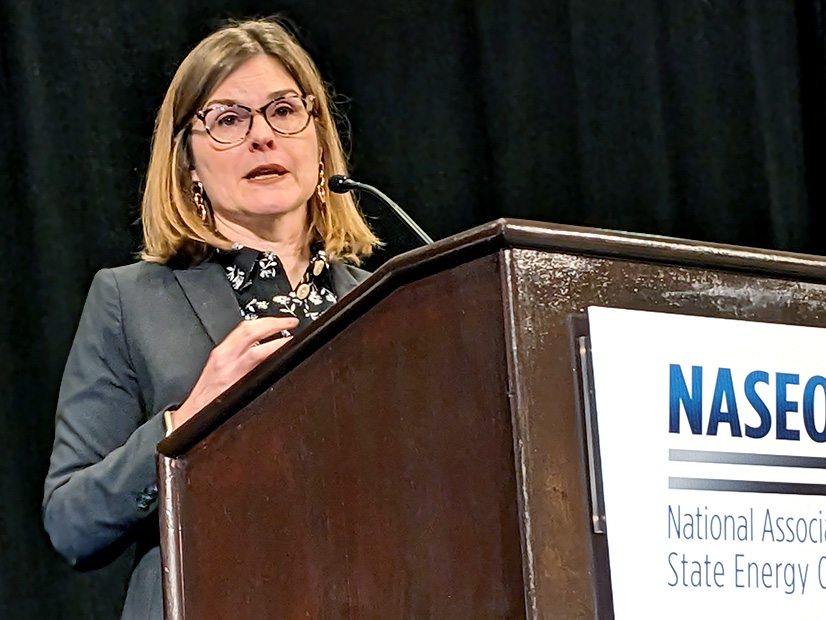WASHINGTON ― State energy offices have a key role to play in transmission planning, and they can and should take action even before FERC finalizes its rules on regional planning and cost allocation, Commissioner Allison Clements told a packed ballroom at the National Association of State Energy Officials’ (NASEO) Winter Policy Summit on Wednesday.
“There’s a feeling around Washington, perhaps, that FERC’s got this under control; we’re going through this transition,” Clements said, referring to the commission’s much-debated notice of proposed rulemaking on transmission planning issued last April. “FERC can cross every ‘t’ and dot every ‘i’ [for] the perfect transmission planning and cost allocation rule, but if the states [haven’t] bought in and if the rest of the pieces related to getting transmission done, from cost allocation to siting, aren’t considered together, we won’t get it done. …
“You have an opportunity to decide by being proactive in your state in these federal jurisdictional planning processes how you want this to play out,” she said.
State regulators and utilities are generally seen as having the primary power for transmission planning at the state level, but Clements and others at the conference argued that energy offices can act as hubs for bringing together public, private and community stakeholders, as well as fostering regional and cross-state collaborations. Such state-level efforts could include not only planning for new transmission, but also upgrading lines with grid-enhancing technologies (GETs).
“Transmission is the No. 1 solution to the reliability, costs and security of our system. That is the reality today,” Clements said. “The other reality is that money is going to be spent. … And the question is how are we going to direct that money? How can we make that money be spent well, so that customers 10 years from now, 15 years from now, 20 years from now are not left holding the bag on a system that is under-matched for the challenges at hand?”
The development of transmission for offshore wind is ripe for regional planning, Clements said, pointing to the efforts of five New England states to secure up to $250 million in federal funding from the Infrastructure Investment and Jobs Act. (See New England States Group up to Push for Federal Transmission Funding.)
“Current transmission system planning wasn’t designed to create a whole new grid, which is effectively what a regional offshore wind system is,” she said.
The first offshore wind projects now under development are being laid out with radial lines connecting them to onshore substations, which is “not the most cost-effective way to get significant capital transition investment done,” Clements said.
“If we start as a group of willing states, whether it be offshore or onshore in your region, and start talking about what a robust set of investments look like 10 years forward, you have the opportunity to not slow down the current procurements, which your states are very focused on, but to have a parallel track to be thinking forward about what you want that to look like,” she said.
Clements also encouraged state energy offices to actively promote the use of GETs — such as dynamic line ratings and advanced conductors — to increase the capacity of existing lines while saving millions for grid operators and customers.
Citing a 2021 report from the Brattle Group, for example, Clements said a combination of GETS could double the amount of renewable energy that could be interconnected on existing lines.
While some projects have been successfully completed, GETs are not being widely adopted, Clements said, first because of misaligned incentives. “Why would a transmission owner or a utility want to make an investment that would actually decrease its need to increase its rate base?” she said.
A bigger challenge, however, is the jurisdictional split between FERC and the states, and transmission and distribution, Clements said. “FERC usually focuses on the bigger transmission investments; states are usually focused on the distribution system,” she said. “We have to close that gap, and I think it is incumbent on all of us to talk to our regulators about the opportunity for grid-enhancing technologies; to ask our utilities about it; to put a little friendly pressure on; to say, ‘What are you doing on this?’”
Spurring Private Investment
Estimates vary of just how much new transmission the U.S. will need to achieve a carbon-free grid by 2035 and a net-zero economy by 2050. A much cited 2021 study from Princeton University called for a threefold increase in transmission capacity, while a recent study from the National Renewable Energy Laboratory said the amount of new transmission needed will depend on the generation mix, setting a range of 1.3 to 2.9 times current capacity.
 Maria Robinson, DOE | © RTO Insider LLC
Maria Robinson, DOE | © RTO Insider LLC
The IIJA includes $10.5 billion for a new Grid Resilience and Innovation Partnerships program, and Maria Robinson, director of the Department of Energy’s Grid Deployment Office, said the first round of funding for the program, totaling $3.8 billion, had drawn hundreds of concept papers.
“What excites me most about what’s going on here is that there are lots of really phenomenal ideas for rapid resilience … whether that is coming from utilities directly, or munis or co-ops, you have lots of terrific ideas on how they want to modernize,” Robinson said.
Echoing Clements, Robinson sees state energy offices as being able to extend the reach of federal funding to look “at how we continue to use this momentum to spur greater investments moving forward from the private sector as well … to ensure we’re getting the best bang for our buck.” Ongoing collaboration between DOE and state energy offices is an integral part of Robinson’s vision for “figuring out where the needs are.”
Robinson acknowledged some of the frustrations raised by the funding limitations, specifically that some of the IIJA funds for grid resilience cannot, at this time, be used to include generation from microgrid projects. “It’s just terrible,” she said. “We are working really hard to figure out if there are other places where we might be able to find that money” for microgrids to be included in grid resilience projects, she said.
Convening, Informing, Engaging
Karen Wayland, CEO of the GridWise Alliance, sees the blurring of lines between state and federal jurisdiction as a result of the higher profile states are taking in setting their own clean energy targets. As a result, she said, state energy offices need to be actively engaged with their governors, legislatures and grid operators.
According to the U.S. Energy Information Administration, 31 states and the District of Columbia have set renewable portfolio or clean energy standards.
“We’re trying to design a system to meet state and federal goals, and so that means that the states have to be involved in the infrastructure that’s necessary to be that platform to meet their decarbonization and their security goals,” Wayland said in an interview with RTO Insider. “They have a really important role to play in convening the relevant stakeholders at the state and local level to kind of guide them to an understanding of the goals that that expanded transmission would address.”
State energy offices also “have a big role to play” in coordinating stakeholder discussions on high-voltage transmission lines being planned to connect nodes within their states, to help determine “whether and how and where a transmission line will be built.”
 David Terry, NASEO | © RTO Insider LLC
David Terry, NASEO | © RTO Insider LLC
NASEO President David Terry sees state energy offices being able to take a broader view of energy market evolution than state regulators typically can because of the statutory limitations of their work.
State energy offices can “work with local communities on behalf of your governor, on behalf your legislature, to inform them of why the state is going in a certain direction with their energy activities,” Terry said. “Why a transmission line may be important; what’s the value to them … what’s the long-term benefit. For the average voter or consumer, this is not exactly top of mind.”
While “kind of soft and a little bit amorphous,” Terry said, the stakeholder engagement and public education roles of energy offices do have an impact on state-level decision making. They can “look across all of these new demand[-and-]supply issues … and they can take in some of those concerns that private sector industry has,” he said. “I think that informs the process. Nothing will make it easy, but it informs it so at least the best decisions can be made.”


